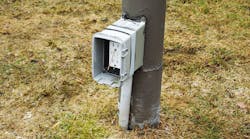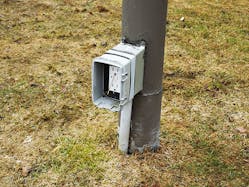How well do you know the Code? Think you can spot violations the original installer either ignored or couldn't identify? Here's your chance to moonlight as an electrical inspector and second-guess someone else's work from the safety of your living room or office. It's your turn to identify the violation.
Hint: Disappearing act gone bad
Find the Answer
Although this installer tried to do all of the right things, it seems as though the cover for this box has disappeared — or perhaps it was a last step that was forgotten. Either way, it leaves us with a Code violation to discuss. Just don’t ask me to tell you what’s sticking out of that top ground pin opening or how it got there.
Section 406.9(B)(1) requires 15A and 20A receptacles installed in a wet location to be provided with an enclosure that is weatherproof with the plug cap inserted or unplugged. The hood for the enclosure must be listed and identified as an “extra-duty” type of outlet box hood. Extra-duty covers generally have more durable hinges than the type of box shown in this photo. This may be why the cover is missing from this box. Rain and moisture can now come into direct contact with this receptacle. This moisture can cause premature equipment failure and certainly increase the shock hazard. The installer also failed to remove any of the pry-out tabs for the cords to pass through in order to allow the cover to be closed when a cord is plugged in. This could be another reason why the cover may be missing. Section 406.9(B)(1) also requires this receptacle to be listed as a weather-resistant type.





